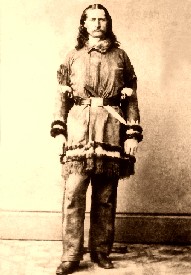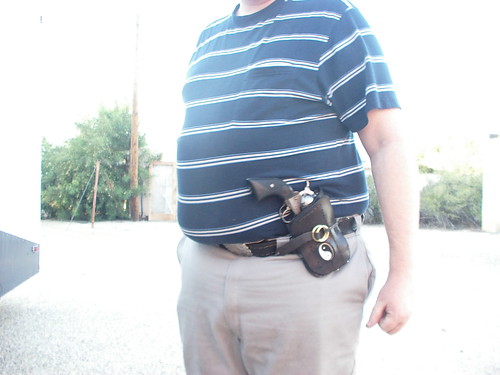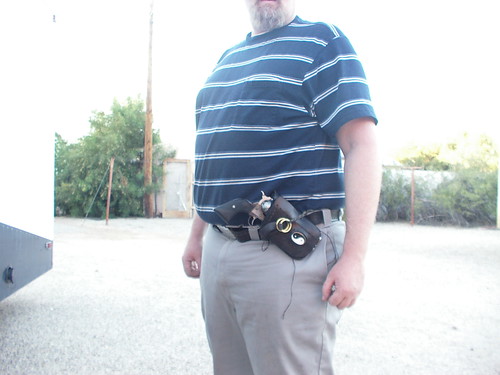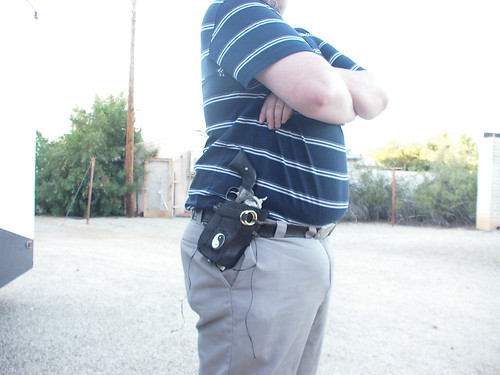You are using an out of date browser. It may not display this or other websites correctly.
You should upgrade or use an alternative browser.
You should upgrade or use an alternative browser.
Cross draw
- Thread starter catken
- Start date
It was called getting the drop or "bulge" on your enemy. Quick draws were hollywood BS. Granted when someone tries to kill you, you get your gun asap. Holsters back then were made to hold your gun securely and keep it from hitting the ground. They were worn high, on the waist not low slung on the hips like on Bonanza.
Holsters back then were made to hold your gun securely and keep it from hitting the ground. They were worn high, on the waist not low slung on the hips like on Bonanza.
True again. Holsters in the day weren't made for fast draw. They covered all the cylinder and all but the tip of the hammer, some if not most prolly covered that too. Most were a snug fit because hammer thongs weren't used either. It generally took both hands to draw. One to pull pistol the other to hold holster down(no leg ties either) These were copied from original Mexican double loop holsters. Typical of what would have been seen in the old west(but only one). Stag grips weren't seen either.

Here's another pic of an authentic type holster. See how it covers the pistol.


Also another pic of ol Bill. Note the holsters. Note how high he wore them. Also note that the holster on his left (your right) that it is a "straight hang" not angled like a modern "cross draw".

Hope it's clear enough.
William (Buffalo Bill) Brooks, horse theif and outlaw. High ridin' belt.



Also another pic of ol Bill. Note the holsters. Note how high he wore them. Also note that the holster on his left (your right) that it is a "straight hang" not angled like a modern "cross draw".

Hope it's clear enough.
William (Buffalo Bill) Brooks, horse theif and outlaw. High ridin' belt.

Last edited:
Here are two Texas Rangers The first is William Callicot, he is wearing his gun cross draw fashion.

The second is Sgt. Ira Aten, he also has his gun cross draw but notice he apparently slid his strong side holster around to his left side with his knife.

This is a cowboy, Joe Ming in 1888.

Notice how high his belt is.

The second is Sgt. Ira Aten, he also has his gun cross draw but notice he apparently slid his strong side holster around to his left side with his knife.

This is a cowboy, Joe Ming in 1888.

Notice how high his belt is.
Smokin_Gun
New member
Those are or were called Bucket Holsters...authentic type holster
Real nice coversion you have there too...
bedbugbilly
New member
Damn Hog . . . . the photos you post are better 'n the centerfold of the latest issue of Playboy magazine . . . . well . .. almost . . . it'd probably be a tie! 
Damn Hog . . . . the photos you post are better 'n the centerfold of the latest issue of Playboy magazine . . . . well . .. almost . . . it'd probably be a tie!
Me? Surely not. MJN's pics are better than mine.
When carried high as they were in the day, cross draw was advantageous for long barreled guns.
Maybe not stag in the 1800s, but IIRC jigged bone was a common cowboy "fixer-upper" replacement stock material, and there are plenty of very old stag grips out there that suggest they may have been used by the end of the cowboy era.....maybe??? Interesting. I never thought about stag not being used in the late 1800s. Not to sidetrack this thread, I'll start another to learn more about the history of stag grips.Stag grips weren't seen either.
Last edited:
I'm of the opinion that Bill did do a double crossdraw. A lot of the photos we have available were definitely staged as hell - this one is a classic example:

There ain't no way he carried with either a big bare blade like that or with his guns "fluffed out" - all of which is clearly for visual effect. Remember, getting your picture taken was a really big deal, a "high tech and new thing" that people dressed up for. You also had to stand there for a while for the slow as hell exposures.
I carry an SA daily in a crossdraw setup of my own design that allows major adjustments to both ride height and tilt angle. This is my favorite setting, which is pretty similar to how Bill carried (but only one gun of course):

This setup is very "high and tight", more or less similar to how Bill carried.
Because of the adjustments available I've tried (briefly) a more "conventional" lower-and-more-horizontal setup:

I can also change the tilt angle around completely and set it up for lower strongside carry:

If you're curious about how this holster works, go here:
http://www.thehighroad.us/showthread.php?t=418769
Back on topic: there's a way to draw from the same side as the gun with butt-forward carry, but it ALWAYS leads to sweeping your own body. It's called the "Prairie Twist Draw". A good pic is available at:
http://www.willghormley-maker.com/AdvantagesOfCrossDraw.html
This will get you tossed out of any match and most ranges. I *do* practice it some, with an unloaded gun ONLY, because if my right hand is tied up, shot up or broke I may have to get to it off-handed.
But it's not my standard draw at all and I don't think it was Bill's.

There ain't no way he carried with either a big bare blade like that or with his guns "fluffed out" - all of which is clearly for visual effect. Remember, getting your picture taken was a really big deal, a "high tech and new thing" that people dressed up for. You also had to stand there for a while for the slow as hell exposures.
I carry an SA daily in a crossdraw setup of my own design that allows major adjustments to both ride height and tilt angle. This is my favorite setting, which is pretty similar to how Bill carried (but only one gun of course):

This setup is very "high and tight", more or less similar to how Bill carried.
Because of the adjustments available I've tried (briefly) a more "conventional" lower-and-more-horizontal setup:

I can also change the tilt angle around completely and set it up for lower strongside carry:

If you're curious about how this holster works, go here:
http://www.thehighroad.us/showthread.php?t=418769
Back on topic: there's a way to draw from the same side as the gun with butt-forward carry, but it ALWAYS leads to sweeping your own body. It's called the "Prairie Twist Draw". A good pic is available at:
http://www.willghormley-maker.com/AdvantagesOfCrossDraw.html
This will get you tossed out of any match and most ranges. I *do* practice it some, with an unloaded gun ONLY, because if my right hand is tied up, shot up or broke I may have to get to it off-handed.
But it's not my standard draw at all and I don't think it was Bill's.
Jim-
You may be of that opinion, but eye witness accounts, known friends and researchers of Bill Hickok disagree with you. Read about him. It was a common way to carry AND draw back then. The reverse cavalry draw or "praire twist" is not dangerous. With an unloaded single action revolver, try this. As you draw the gun you are cocking the hammer, twisting the gun around and bringing it up on target. While doing this try to "fire" the gun while drawing. It isn't as easy as you may think. The way your thumb twists on the hammer makes it ptetty tough to let go of it. Hell, the cavalry troopers did it that way( reverse CAVALRY draw). And "gunfighters" didn't worry about matches or range officers tossing them out when someone tried to kill them.
As far as "cross" draw, time yourself and see how long it takes to reach all the way across your body, get hold of your gun THEN pull it. Then time yourself with a strong side draw. Like I said earlier, I carry SA revolvers in a cross draw fashion so this is not about my preference. Cross draw is better when mounted (seated) but that's really the only benefit.
Again, look at 1800 period photos and see how many "cross draw" holsters you come up with.
You may be of that opinion, but eye witness accounts, known friends and researchers of Bill Hickok disagree with you. Read about him. It was a common way to carry AND draw back then. The reverse cavalry draw or "praire twist" is not dangerous. With an unloaded single action revolver, try this. As you draw the gun you are cocking the hammer, twisting the gun around and bringing it up on target. While doing this try to "fire" the gun while drawing. It isn't as easy as you may think. The way your thumb twists on the hammer makes it ptetty tough to let go of it. Hell, the cavalry troopers did it that way( reverse CAVALRY draw). And "gunfighters" didn't worry about matches or range officers tossing them out when someone tried to kill them.
As far as "cross" draw, time yourself and see how long it takes to reach all the way across your body, get hold of your gun THEN pull it. Then time yourself with a strong side draw. Like I said earlier, I carry SA revolvers in a cross draw fashion so this is not about my preference. Cross draw is better when mounted (seated) but that's really the only benefit.
Again, look at 1800 period photos and see how many "cross draw" holsters you come up with.
Last edited:
